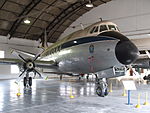Main aircraft
The main presidential aircraft currently used to transport the President of Brazil provisionally are two military version Airbus A330-200s with callsign (FAB-2901 and FAB-2902) designated by the Brazilian Air Force as KC-30.
The presidency also uses two modified Embraer 190 jets, Air Force designation VC-2, christened as "Bartolomeu de Gusmão" and "Augusto Severo", for presidential travel within Brazil and South America. The Brazilian Air Force purchased the aircraft on 2 June 2008 to replace the two Boeing 737-2N3 (VC-96) that were previously used for short-range presidential transport. The aircraft is configured with special communications systems, a private presidential office and a meeting room. It has the capacity for carrying 40 passengers with a range of over 2,500 miles. [2]
Other aircraft

Along with the VC-1A and the VC-2s, 21 other aircraft are part of the fleet:
- Two VIP-configured Eurocopter EC725 (VH-36) presidential helicopter.
- Two VIP-configured Eurocopter Super Puma (VH-34) presidential helicopters.
- Two VIP-configured Embraer ERJ-145 (VC-99C) aircraft.
- Ten Embraer ERJ-145 (C-99A) jets.
- Three Gates Learjet 35 (VU-35) jets.
- Two Eurocopter EC135 (VH-35) helicopters
The VIP fleet is stationed at Brasília Air Force Base (BABR) and operated by the Special Transportation Group (GTE). [3]





